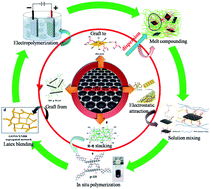Recent advances in the synthesis and applications of graphene–polymer nanocomposites
Abstract
Graphene (G)-based nanocomposites have received much attention in various disciplines due to their high specific surface area, good compatibility, low mass density, elegant flexibility as well as the excellent synergistic effect of G with other nanomaterials. Numerous studies have been carried out to fabricate G-based polymer composites with novel and improved properties. However, the dispersion behavior of G in a polymer matrix and the interfacial bonding between G and polymers still restrict the better performances and broader applications of the fabricated G–polymer nanocomposites. In this review, we have summarized the most recent studies on the modification of G with polymers and the subsequent synthesis and applications of high quality G–polymer nanocomposites. The strategies for surface modification of G with polymers, including various covalent and non-covalent techniques, are introduced in detail. In addition, a series of effective processing routes for producing high quality G–polymer nanocomposites, such as melt compounding, solution blending, in situ polymerization, latex mixing, and electropolymerization, are introduced and discussed. Finally, the potential applications of the synthesized G–polymer nanocomposites in electrocatalysts, drug delivery, high performance materials, biosensors, and biomedical materials are presented.


 Please wait while we load your content...
Please wait while we load your content...